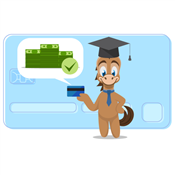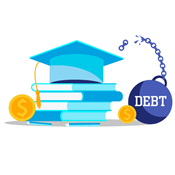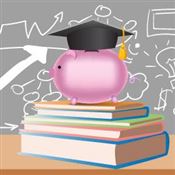How to Get Out of Student Loan Debt
Feeling trapped by your student loans? There are legal ways to erase that debt without paying. Read on to find one that may work for you.
 |
| © CreditDonkey |
The terms forgiveness, cancelation, and discharge basically mean the same thing - getting out of your loans without paying them off. But each falls under a different set of criteria. Let's start with ways to discharge your loans.
LOAN DISCHARGE
You can get federal loans discharged due to a catastrophic event. These include the student's death, false certification from the school, a school closing down, and a change in the health of a student (such as disability).
Closed School
If you went to a school, either in the United States or overseas, that closed, you may be eligible for a federal loan discharge.
- School closed after obtaining loan.
- School closed while enrolled.
- School closed within 120 days after you withdrew.
Read here to learn more about loan discharge due to school closure.
ITT students should contact the Department of Education, which can be reached at: 1-800-433-3243.
Passing of a Student
A federal loan can be discharged when a student, or a parent borrower of a PLUS loan, dies.
The federal loan servicer handling the student's loans will require a certified death certificate to authenticate it and then discharge the loans.
- Did your parent take out a PLUS loan for your education, and are they now deceased?
- Are you the parent, and the student is now deceased?
Disability
If a student becomes disabled and is no longer able to perform the duties for which they received the federal student aid, they may be eligible for a discharge.
- Are you permanently disabled?
- Does your disability prohibit you from doing the work for which you took out the student loan?
A student who attended a career college for Commercial Driver's License training may be eligible for a discharge after becoming an insulin-dependent diabetic.
Or, if you are a veteran, you may qualify for discharge if you have received a VA disability.
Read here to learn how to get your loans discharged due to total and permanent disability.
Bankruptcy
In rare cases, you may have your federal student loan discharged in bankruptcy. The bankruptcy court must determine that repayment would impose undue hardship on you and your dependents.
After you declare Chapter 7 or Chapter 13 bankruptcy, the hardship must be decided through proceedings in bankruptcy court.
If you have not filed for bankruptcy, and you feel you meet the financial and hardship qualifications, meet with a bankruptcy attorney.
Read here to learn more about student loan bankruptcy discharge.
False Certification of Eligibility or Unauthorized Signature/Payment Discharge
You may be eligible for discharge of your direct or federal loans by meeting criteria surrounding false certifications, signatures, or authorization.
- Did your school falsely certify your eligibility to receive the loan based on your ability to benefit from its training?
- Was your loan falsely certified because you were a victim of identity theft?
- Did the school certify your loan eligibility but, due to extenuating circumstances, you cannot meet state requirements for employment in the area for which you were trained?
- Did the school sign you name on the application or promissory note without your authorization?
- Did the school endorse your loan check or authorized for electronic funds transfer without your knowledge, and the money was not given to you or applied to charges that you owed to the school?
Read here to learn more about false certification of student eligibility or unauthorized signature/payment discharge.
Unpaid Refund Discharge
Your school may be required to return a portion of your loan money if you withdrew from school after receiving a student loan.
Did you attend the school for less than 60% of the academic period for which your loan was issued?
Check with your school to find out how federal refund policies apply to federal aid at the school. Also, contact your loan servicer for additional information.
Keep reading to learn about loan forgiveness options.
Loan Forgiveness
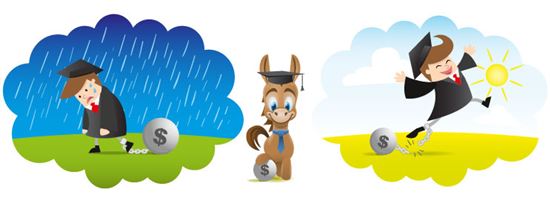 |
| © CreditDonkey |
Most loan forgiveness programs pay for a portion of student loan debt. This is a great way to greatly reduce, delay, or reorganize your payments or repayment status.
Public Service Loan Forgiveness (PSLF)
If you work for a government agency or nonprofit, you may be eligible for Public Service Loan Forgiveness.
- You MUST be enrolled in one of the four Direct Loan Program repayment plans to qualify.
- You must work full-time and make 120 qualifying payments. Payments made before enrollment don't count as qualifying payments towards PSLF.
- After 10 years of payments in any of the above plans, your loan balance may be forgiven.
If you have Federal Perkins Loans and/or Federal Family Education Loans (FFEL), you must consolidate them into a Direct Consolidated Loan in order to qualify for PSLF. Then you have to make 120 payments towards the new consolidated loan.
Federal Perkins Loan Cancellation and Discharge
Perkins Loans are no longer offered. But if you took them out before the expiration, you may be eligible for Federal Perkins Loan Cancellation.
Look into this option before you consolidate your Perkins Loans. Once you consolidate, you may no longer be eligible.
This forgiveness program offers 100% forgiveness in just 5 years. You get a fixed percentage of loans (plus interest) forgiven for each year of service:
- 15% for the 1st year
- 15% for the 2nd year (total 30%)
- 20% for the 3rd year (total 50%)
- 20% for the 4th year (total 70%)
- 30% for the 5th year (total 100%)
Several professions are eligible for this program, including teachers, nurses, firefighters, and law enforcement officers.
You must have taken out the Perkins Loan before 9/30/2017. And the loan can't be cancelled the same year it was disbursed. It's up to your school to decide if you qualify for forgiveness.
Loan Forgiveness for Teachers
Teachers working at a low-income school for five consecutive years may qualify for loan forgiveness for teachers.
- You must have state certification and have a license to teach in your state. Your loan cannot be in default, either.
- Elementary school and middle school teachers may receive up to $5,000 in forgiveness. Teachers who specialize in math, science, or special education may receive up to $17,500 in forgiveness.
Loan Forgiveness for Nurses
Nurses have several forgiveness programs available to them.
- Nurse Corp Loan Repayment Program: Eligible for nurses, RNs, APRNs, and nurse educators who work in an eligible Critical Shortage Facility or teach in an eligible public or private nonprofit school of nursing.
After 2 years of service, you can get 60% of loan repayment. After another year, you can get 25% more.
- National Health Service Corps Loan Repayment Program: Provides loan repayment for health professionals working in medically underserved areas. This includes nurse practitioners and certified nurse-midwives.
You can get up to $50,000 of repayment for a 2-year service.
Loan Forgiveness for Doctors
National Health Service Corps provides up to $50,000 towards medical school debt for those serving in Health Professional Shortage Areas.
- Eligible fields include: primary care medical, dental, and behavioral health professional.
- After your 2-year commitment, you can apply to continue your service in exchange for further loan forgiveness.
Loan Forgiveness for Military
Army
The Student Loan Repayment Program offers active members 33.33% of your loan balance for each year of service, up to $65,000 for 3 years.
You must request the Loan Payment Program BEFORE enlisting. Also, you must score at least a 50 on the Armed Services Vocational Aptitude Battery.
Navy
The Student Loan Repayment Program offers Navy service members up to $65,000 over the course of 3 years.
To qualify, you must have had the loan prior to enlisting in the Navy. Also, you must include your application for the Repayment Program prior to enlisting.
Air Force
The Student Loan Repayment Program is available to members of the Air Force Judge Advocate General Corps.
You can get up to $65,000 over a 3-year period. This is paid directly to your student loan provider.
Your state may have its own loan forgiveness program, too. Read on to learn more.
CHECK YOUR STATE FORGIVENESS PLANS
On top of the federally-funded forgiveness plans, state plans are often available. These vary by where you live.
Most of the plans are for nurses, doctors, lawyers, teachers, and veterinarians. But you can also find programs for other professions. These programs often require you to work in an underserved area.
New York offers repayment for social workers through the NYS Licensed Social Worker Loan Forgiveness Program.
This program offers up to $26,000 in loan forgiveness. Requirements include:
- Living in NY for a year
- Being a licensed social worker
- Not being in default on your student debt
Texas offers the Loan Repayment Program for Speech-Language Pathologists and Audiologists. This encourages students to work in speech-language pathology. The requirements and amount offered differ.
It's worth checking out what your state has to offer. You never know when there is free money available.
Have a loan forgiveness questions we haven't answered? Keep reading.
Common Loan Forgiveness Questions
That depends on the program you apply for. For an income-driven repayment plan, it can take up to 25 years of payments before your loans are forgiven.
The PSLF program forgives your loans after 10 years. Other programs for teachers, nurses, and doctors can have loans forgiven in a little as 2 years.
Are federal student loans forgiven at age 65?
No. In the US, age-based loan forgiveness does not exist. In fact, the federal government can reduce your Social Security retirement benefits if you default on your student loan.
Do they forgive student loans after 20 years?
The federal income-driven repayment plans will forgive any remaining federal student loan debt after 20 years of payments (or 25 years, depending on your plan). You can enroll in one of the forgiveness programs if you have Direct Federal Loans.
Can student loans be removed from my credit report?
Student loans are only removed from credit reports after they are fully paid. Negative remarks (such as a late payment) will stay on your credit report for 7 years before being removed.
If you're in default with federal loans, a one-time rehabilitation option is available that will remove negative remarks and bring your loan current.
Don't qualify for loan forgiveness? Read on to learn about employee assistance programs.
EMPLOYEE ASSISTANCE PROGRAMS
Student Loan Repayment Plans (SLRPs) are gaining popularity as a company benefit offered by employers.
SLRP options:
- Employer pays the student loan off in full.
- Employer pays a portion of the student loan.
Check with your employer to find out if they offer the SLRP benefit. You'll also need to know about specific eligibility and benefit parameters they have in place.
Ways to Repay Your Student Loans
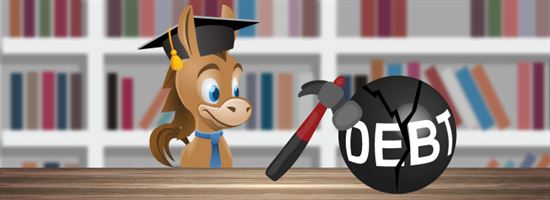 |
| © CreditDonkey |
If you're not eligible for loan cancelation, discharge, loan forgiveness, or employee assistance programs, then it's time to look into your repayment options.
There may be ways to lower the amount you pay over the life of your loan.
Income-Driven Repayment Plans
With these plans, your monthly payment is based on your income. If you earn very little, your payments could even be $0. After 20 - 25 years of payments, the rest of the balance will be forgiven.
You can enter one of four income-driven repayment programs. But here are some things to know first.
- Only Federal Loans are Eligible: Direct and Direct PLUS Loans are eligible. If you have other loans (such as Federal Stafford Loans or Perkins Loans), you may need to consolidate them into a Direct Consolidated Loan.
Private loans and Parent PLUS loans are NOT eligible.
- Your Payment is Based on Your Discretionary Income: You monthly payment can be as little as 10% of your discretionary income. If you earn very little, your monthly payments could even be $0.
Your discretionary income = Your adjusted gross income - 150% of the federal poverty level for your family size.
For example, 150% of the poverty level for a family of 1 is $18,090. If your income is $40,000 a year (after taxes), your discretionary income = $40,000 - $18,090 = $21,910.
Here are the available income-driven payment plans:
Income-Based Repayment (IBR)
You must have Federal Direct Loans or Federal Family Education Loans (Stafford, Federal PLUS Loans, and Federal Consolidation Loans) to qualify.
For loans taken out AFTER July 1, 2014: Students pay 10% of their discretionary income. After 20 years of payments, any leftover amount is forgiven.
Remember: as your income increases, so does your payment. The maximum payment is the amount of the Standard Repayment Plan's payment.
As a bonus, the government will pay your interest on subsidized loans for the first 3 years. After that, the unpaid interest may get added to your principal balance. Luckily, this doesn't happen until your IBR payment equals the Standard Repayment payment.
You have $50,000 in student loans with an interest rate of 5%.
Under a Standard Repayment Plan, you will owe a total of $63,640, including interest. Your annual adjusted income is $30,000.
You enter the Income-Based Repayment plan with a monthly payment of $148/month.
After 25 years of payments on this plan, you will have paid a total of $44,662. The rest is forgiven at that point.
While you may get some of your balance forgiven with this type of loan, you can also pay a lot more in interest.
You'll be making payments for 20 - 25 years rather than the Standard Repayment Plan's 10 years.
Pay As You Earn Repayment (PAYE)
Fewer graduates will be eligible for this program because of date restrictions.
- You must be a new borrower after October 1, 2007. In other words, you must not have any student loans dating before this date. You must also have taken out an eligible loan after October 1, 2011.
- Payments are 10% of your discretionary income. If you don't have an income right now, you don't have a payment.
- Your outstanding balance is forgiven after 20 years of payments
This loan's max payment also equals the Standard Repayment plan payment. Interest payback begins when you reach that amount.
Revised Pay As You Earn Repayment (REPAYE)
The REPAYE program is for students who don't fall into one of the above categories. There are no date restrictions. Only Parent PLUS loans and most private loans are excluded.
- Payments are 10% of your discretionary income.
- There is no cap on the payments, unlike the other plans we discussed thus far. As your income increases, so do your payments. This could make for some hefty payments if you become successful.
- Your outstanding balance is forgiven after 20 years of payment. Because there is no payment cap, you won't have any interest added to your principal balance.
Income-Contingent Repayment (ICR)
This is the only repayment plan available for borrowers with Parent PLUS loans. To be eligible, the Parent PLUS loans must first be consolidated into a Direct Consolidation Loan.
- For the ICR plan, discretionary income = your adjusted gross income - 100% of the poverty level (instead of 150%).
- Your payment is 20% of your discretionary income OR payments based on a 12-year repayment plan, whichever is less. This payment may also exceed the Standard Repayment Plan monthly payment.
The government does not subsidize any unpaid interest. 100% of the unpaid interest gets added to your loan balance annually. However, no more than 10% of the loan balance will be added.
Refinancing Your Loan
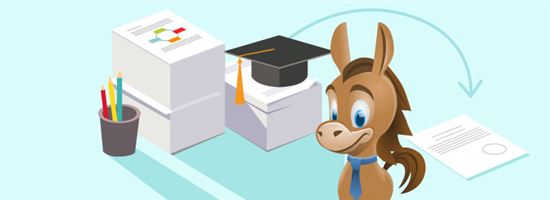 |
| © CreditDonkey |
Not eligible for income driven repayment plans? You can lock or lower your interest rate by refinancing your loan.
Refinancing won't get you out from under your loan without paying. But it can make your loan more affordable, which means you can the debt off quicker.
Lowered interest rates mean less money owed over the life of your loan. Your lender will automatically adjust your repayment terms when your interest rate is adjusted.
If you pay more than the monthly amount on your loan after your interest rate is lowered, you are paying your loan off quicker by chipping away at the principal amount due.
HOW TO LOCK OR LOWER YOUR INTEREST RATE
When taking out your student loans, you signed an agreement to repay the loan at a set interest rate. That rate may have been variable, which means you're not stuck with that rate forever.
By refinancing with a private lender, you take out a new locked, low-interest rate student loan that pays off most or all your existing student loans.
Always weigh out the pros and cons of refinancing before applying.
Refinancing your student loans can result in thousands of dollars saved on interest. When you find the right lender, you can obtain a lower interest rate.
This means a higher percentage of your payments chip away at your principal balance, which also means you pay less interest over the life of the loan.
Read on to learn more about this smart money saving option.
HOW TO FIND THE BEST STUDENT LOAN REFINANCE OPTION
Student loan refinance options vary. You'll want to shop around with private lenders to find the best offer. The best student loan refinances often have:
Lower Interest Rates
The point is to save money. You want to find an interest rate that is lower than what you pay now. Interest rates vary because they are based on individual credit and income.
Check the rates from several lenders. And make sure to keep the search within a 14-day window. This way, it only counts as one credit inquiry on your credit report.
Hard Credit Pull: will drop your credit score by at least a couple of points and sometimes more.
Read more on how to improve your credit score.
Fixed Interest Rate
With a fixed rate, you don't need to worry about future interest rate increases. Your monthly payment might go up if your interest rate increases.
If you aren't sure how long you'll need to pay off your debt, stick with a fixed rate loan.
No Fees
You don't have to pay origination fees for a private student loan. Keep in mind that if you know you can pay your loan off early, a variable rate might be your best option.
Variable rates are often lower than fixed rates. This can save you money over the life of your loan.
Keep reading for some common refinancing questions:
COMMON REFINANCING QUESTIONS
Refinancing student loans gives you the option to find a better rate and term. Consolidating your federal student loans means lumping multiple loans into one. You pay a weighted average of all interest rates on your loans.
Consolidating doesn't usually save you money. It simply reorganizes your student debts. You can refinance both federal and private loans, but you can only consolidate federal student loans as they are part of a federal program.
Keep in mind that with consolidation, you may enter an income driven repayment plan which could have up to a 25-year repayment period. If you decide to refinance, you will lose out on any federal loan benefits that you may have accrued, such as federal loan forgiveness.
What credit score do you need to get approved?
It goes without saying: the higher your score, the better. Each lender has their own requirements. Basically, they don't want late payments, collections, or any type of default on your credit report.
Lenders don't focus solely on your credit score, but it's certainly a factor. They'll also look at your employment history, savings patterns, and potential for the future too.
How do you prove you can afford the refinance?
The lender will ask you for appropriate documents. Be prepared to show your last few pay stubs and tax returns.
Lenders will look for consistent income and employment over the last year or so. They don't base your approval solely on your income. But it does play a big role.
How do you qualify for a refinance?
If you decide to refinance your student loans, there are some steps that you must take to qualify.
- Be prepared to answer questions like:
- What loans do you have?
- What are the interest rates?
- Are you able to afford a monthly payment?
- What loans do you have?
- Visit one or more of the websites here and fill in your information.
- When you receive offers, make sure to read and understand the rates and terms.
- Finally, accept the terms of your chosen loan refinance offer. You're now on your way to lower student loan interest rates.
Keep reading for some creative ways to speed up your loan payoff.
CREATIVE WAYS TO ACCELERATE PAYOFF
Use Your Credit Card Rewards
Reward points and cash back are good for more than just shopping or travel. You can also use them to pay off your student loan debt.
For example, the Citi ThankYou Preferred Card allows you to convert their reward points into a student loan rebate voucher to make an extra payment.
Put Windfalls to Work
If you received a tax refund, slapping it down on your student loan is a smarter option than spending it on a shopping spree.
If you owe $30,000 in loans, putting an extra $3,000 (the average yearly tax refund) towards the balance will get you debt free a full two years' early.
Imagine how much faster you will pay off your loans if you do this every year.
Consider a Career in the Military
Military service offers an incredible number of benefits, the most important of which is the opportunity to serve your country. But you can also receive a number of loan repayment or education sponsorship benefits.
After meeting several requirements, you can access a number of different military loan repayment programs.
Ask Friends and Family for Help
If your loved ones still give you cash for birthdays or holidays, ask them to redirect the money towards your student loans.
LoanGifting, for example, offers a student a loan gift service that looks a lot like. This allows donors to apply money to your loan balance with just the click of a button.
Many states have investing plans for family members to contribute towards education expenses. Check the programs in your state and talk with family members about options.
Take Advantage of Tax Deductions
Tax season isn't fun for anyone. But being able to deduct $2,500 of your student loan interest makes it easier.
Tax credits are available for college students and graduates. These include the American Opportunity Credit and Lifetime Learning Credit, as well as the interest deduction.
Make sure to speak with a tax professional to make sure that you get the most of benefits that are available to you.
FIND WAYS TO MAKE MORE MONEY
Increasing your income can help you pay off your student loans faster, but that doesn't mean you have to switch careers or get a second job.
You must be willing to put in some time, though. Starting a side hustle, whether it's freelancing, pet sitting, or selling your old stuff on eBay, is an easy way to bring in a few extra bucks.
Remember, when people need a service or product, where do they look first? The internet. An online business is a great way to bring in extra cash, and you don't leave home to do it.
If you're not keen on the idea of working on the side, consider donating plasma or join a clinical study to pull in some extra cash.
Additionally, one of the most overlooked ways to increase your income is to simply ask for raise at work. Do your research and explain why you think you deserve one. You'd be surprised at what you can get just by speaking up.
SMART WAYS TO PAY OFF STUDENT LOANS EARLY
Paying off student loans early isn't easy but it can be done. Here are some tips to help:
Start with the Most Expensive Loans First
Target the loans with the highest interest rates. You may be tempted to pay off the loans with the smallest balance first. But paying down the loans with the highest interest first will ultimately save you the most money in the long run.
Once that first loan is paid off, roll over the payment amount to the next loan with the second highest interest.
Take Advantage of a 0% Credit Card Offer
If refinancing your private loans isn't an option, you can shift some of the balance to a zero-interest credit card.
Credit card companies routinely use 0% promotional offers to attract new customers. Taking advantage of this can give you a breather from higher interest rates.
Before you sign the dotted line on the credit card offer, make sure you have a plan in place to pay off the balance before the promotional period ends.
Otherwise, you will be stuck with an interest even higher than that of student loans.
Make Sure Payments are Applied Correctly
Paying extra on your private loans won't speed up your debt payoff if your lender doesn't allocate the money correctly.
Instead of applying extra amounts to principal, your lender may credit it towards your next month's payment. This won't do much to reduce your interest or make a dent in the balance.
Specifically ask your lender to avoid Paid Ahead status to ensure that your progress isn't slowed down.
Consider a Move
If you borrowed heavily from private lenders, relocating to a cheaper city can make managing your payments easier. Some places even offer additional incentives to entice new grads. Cities like Kansas and Detroit, for example, have programs that provide loan reimbursement for borrowers who are willing to try out a new city.
Bottom Line
Getting out of repaying your student loans is possible if you qualify for loan discharge, cancelation, or forgiveness programs. Also remember to check out state-level forgiveness and employee assistance programs.
Once you have determined that you must pay your loans off, find a plan to make repayment more affordable. These include income-driven repayment plans and lowering your interest rate through refinancing.
Lastly, follow our repayment strategy tips, Smart Ways to Payoff Loan Early. You have numerous options to make repayment more affordable - and possibly quicker through shortened repayment terms.
Write to Mary Humphrey at feedback@creditdonkey.com. Follow us on Twitter and Facebook for our latest posts.
Editorial Note: Any opinions, analyses, reviews or recommendations expressed in this article are those of the author's alone, and have not been reviewed, approved or otherwise endorsed by any card issuer. This site may be compensated through the Advertiser's affiliate programs.
Disclaimer: The information for the Citi ThankYou® Preferred Card has been collected independently by CreditDonkey. The card details on this page have not been reviewed or provided by the card issuer.
Read Next:
